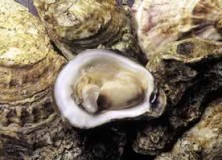While walking on the beach you will likely run into a shell with a bumpy outer layer but a beautiful inside that looks like pearl. This small little creature has a huge impact on the health of the bay and after reading this page you will learn some amazing facts about it.
The oyster native to the Chesapeake Bay is know by the scientific name Crassostrea virginica. An oyster belongs to a family of creatures called “bi-valves”. They have soft muscular bodies with two hard shells to protect their bodies. They eat by sucking in water and filtering nutrients from it. Oysters were once so plentiful that ships had to navigate around them to avoid running aground on them. At the time of the first European explorers of the Bay it is thought that there were so many oysters that they could filter the entire volume of the bay in just two days!! Imagine how clear the water was back then.
Reproduction
Oysters reproduce in the spring and summer when the water temperature of the bay rise. Most oysters are males until they mature at which point they become females. When they reproduce they create larvae which are spread by the currents of the water. A good example of this is the floating oyster farm in Sally’s pond. The larvae from this farm have spread to the nearby rip-rap and jetties where they have attached and become adults.
Oyster larvae need something solid to attach to so that is why you commonly see them covering rocks and pilings. Once a larvae attaches and forms a shell it is called a “spat”. Eventually the oysters will cover what they attach to and even other oysters. These colonies are called reefs. The bay was once filled with thousands of reefs caused by oysters attaching to things over the years.
Predators and Diseases
There are a lot of animals in the bay that feed on oyster. Blue Crabs, Oyster toad fish and drills are but a few of them. There hard shell protects them once they are adults but they are no match to the powerful jaws of the Oyster toad fish which can crush them. Because of these predators; many of the oysters don’t reach the adult stage.
Diseases have been the one thing that has decimated the oyster population in the bay. In the 1950’s a disease organism called “Haplosporidium nelsoni” or MSX started to quickly destroy the oysters in the bay. Researcher believe that this disease was accidentally introduced with the introduction of a Pacific oyster species called “Crassostrea gigas”. The native eastern oyster of the bay had no resistance to this disease and they quickly started to die off in the millions. At the same time they were attacked by a disease called “Dermo” which increased the speed of the oyster die off.
The “Filter” of the bay
Oysters are very important part of the bay ecosystem because of their ability to filter water. If you look at the water in the bay you will notice it has a green tint to it. This is caused by algae and other organisms in the water that feed on nutrients. The more nutrients in the water, the greener the water appears. The nutrients in the waters of the bay are high because of rain washing nutrients off of the land and washing them into the water. These nutrients can be things like fertilizer or animal waste.
As more nutrients are dumped into the bay the water becomes less clear and things that are beneficial start to die off. One of the most important things is the grass beds of the bay. These grass beds are basically the nursery of the bay. It is here that young crabs, rockfish and many other animals thrive.
The plankton and algae that feed off these nutrients also consume oxygen in the water. These organisms consume so much oxygen that there are areas of the bay called dead zones that have oxygen levels that are so lo that there is virtually no life there.
Basically
High nutrients=more plankton & algae = dead zones and green water
Oysters suck in water full of nutrients, filter them out and expel water that is clean. A single oyster can filter up to 60 gallons of water in a single day. That may not seem to make much of a difference in the huge bay but imagine millions of oysters filtering the water and you can see what a big different they make.
The reduction of nutrients entering the bay and increasing the number of oysters in the bay is critical to improving the health of the bay. Lawmakers are working to reduce the amount of nutrients being washed into the bay while experts are finding ways of reintroducing disease resistant strains of native oysters.
Virginia has created and area on the Great Wicomico river just up from Reedville with the purpose of reintroducing oysters to the area. There they have several areas there they have dumped small oysters with the hopes of increasing the number of oysters in the bay.
Hopefully some day the oysters of the bay will become plentiful once again. With the return of the oysters will return the health of the bay. Please check out some of the links below to learn more about oysters. Learn how to start your own oyster garden and contribute to the health of the bay.
More sources of information on Oysters on the internet…
Oyster Fact Sheet – Chesapeake bay foundation
Chesapeake Bay Oysters – thechesapeakebay.com
The native oyster – NOAA
Chesapeake Bay Oyster – Maryland Center for Environmental Science
Great Wicomico River Restoration Efforts….
Great Wicomico River Oyster Restoration Project – NOAA
Native Oyster Restoration Monitoring Program
Students transplant 6500 oysters
Oyster Reefs – NOAA
Oyster Farming…
Oyster supplies – Chesapeake Bay Foundation


